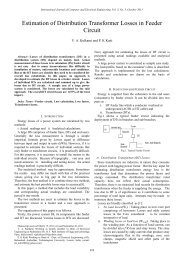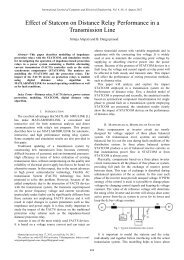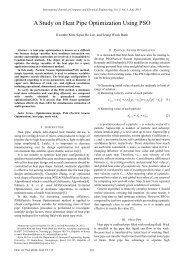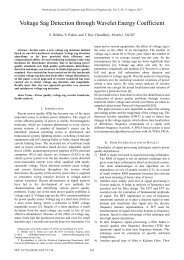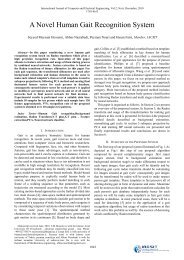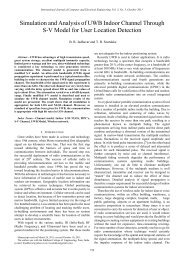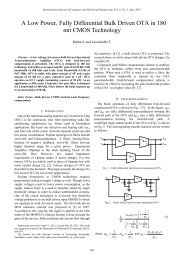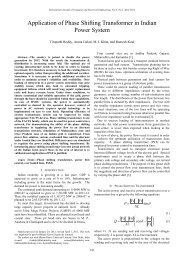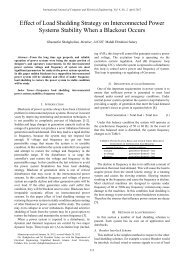International Journal of Computer Theory and Engineering - ijcee
International Journal of Computer Theory and Engineering - ijcee
International Journal of Computer Theory and Engineering - ijcee
You also want an ePaper? Increase the reach of your titles
YUMPU automatically turns print PDFs into web optimized ePapers that Google loves.
<strong>International</strong> <strong>Journal</strong> <strong>of</strong> <strong>Computer</strong> <strong>and</strong> Electrical <strong>Engineering</strong>, Vol. 4, No. 6, December 2012<br />
Multi-Objective Evolutionary Optimization <strong>of</strong> PID<br />
Controller by Chaotic Particle Swarm Optimization<br />
Reza Gholipour, Jalil Addeh, Hamed Mojallali, <strong>and</strong> Alireza Khosravi<br />
Abstract—In this paper, An Intelligent PID Controller has<br />
been tuned by minimizing the Integral <strong>of</strong> Time multiplied<br />
Absolute Error (ITAE) <strong>and</strong> squared control signal (ITAESCS)<br />
for a DC motor. The parameters <strong>of</strong> PID controller,<br />
automatically <strong>and</strong> intelligently are determined by Chaotic<br />
Particle Swarm Optimization (CPSO) Algorithm. The<br />
experimental results demonstrate that the performance <strong>of</strong><br />
proposed Intelligent CPSO-PID controller is superior to the<br />
conventional Ziegler-Nichols method in terms <strong>of</strong> settling time,<br />
maximum overshoot <strong>and</strong> ITAESCS.<br />
Index Terms—PID controller, chaotic particle swarm<br />
optimization, DC motor.<br />
I. INTRODUCTION<br />
Conventional Proportional-Integral-Derivative (PID)<br />
controllers are themost widely used in industry due to their<br />
simple control structure, ease <strong>of</strong> design, <strong>and</strong> low cost<br />
[1]-[3].Unfortunately, it has been quite difficult to tune<br />
properly the gains <strong>of</strong> PID controllers because many industrial<br />
plants are <strong>of</strong>ten burdened with problems such as high order,<br />
time delays, <strong>and</strong> nonlinearities [4]–[9]. Over the years,<br />
several heuristic methods have been proposed for the tuning<br />
<strong>of</strong> PID controllers. The first classical tuning rules proposed<br />
by Ziegler <strong>and</strong> Nichols. In general, it is <strong>of</strong>ten difficult to<br />
determine optimal or near optimal PID parameters with the<br />
Ziegler-Nichols formula in many industrial plants [4]–[6].<br />
For these reasons, it is highly desirable to increase the<br />
capabilities <strong>of</strong> PID controllers by adding new features. Many<br />
artificial intelligence (AI) techniques have been employed to<br />
improve the controller performances for a wide range <strong>of</strong><br />
plants while retaining their basic characteristics. AI<br />
techniques such as neural network, fuzzy system, <strong>and</strong><br />
neural-fuzzy logic have been widely applied to proper tuning<br />
<strong>of</strong> PID controller parameters [4], [5].<br />
Evolutionary algorithms with their heuristic <strong>and</strong> stochastic<br />
properties <strong>of</strong>ten suffer from getting stuck in local optima.<br />
This common characteristic led to the development <strong>of</strong><br />
evolutionary computation as an increasingly important field.<br />
A GA is a stochastic search procedure based on the<br />
mechanics <strong>of</strong> natural selection, genetics <strong>and</strong> evolution [10].<br />
Since this type <strong>of</strong> algorithm simultaneously evaluates many<br />
points in the search space, it is more likely to find a global<br />
solution to a given problem. PSO describes a solution process<br />
in which each particle moves through a multidimensional<br />
search space [11]. The particle velocity <strong>and</strong> position are<br />
constantly updated according to the best previous<br />
Manuscript received October 12, 2012; revised November 14, 2012.<br />
The authors are with the Department <strong>of</strong> Electrical <strong>and</strong> <strong>Computer</strong><br />
<strong>Engineering</strong>, Babol (Noushirvani) University <strong>of</strong> Technology, Babol, Iran<br />
(e-mail: mojallali@guilan.ac.ir, mojallali@gmail.com)<br />
performance <strong>of</strong> the particle or <strong>of</strong> the particle’s neighbors, as<br />
well as the best performance <strong>of</strong> all particles in the entire<br />
population. GAs have demonstrated the ability to reach<br />
near-optimal solutions for large problems; however, they<br />
may require a long processing time to reach a near-optimal<br />
solution. Similarly to GAs, Binary Particle Swarm<br />
Otimization (BPSO) is also a population-based optimizer.<br />
BPSO has a memory, so knowledge <strong>of</strong> good solutions is<br />
retained by all the particles <strong>and</strong> optimal solutions are found<br />
by the swarm particles if they follow the best particle. Unlike<br />
GAs, BPSO does not contain any crossover <strong>and</strong> mutation<br />
processes [12]. Hybridization <strong>of</strong> evolutionary algorithms<br />
with local search has been investigated in many studies [13],<br />
[14]. Such hybrids are <strong>of</strong>ten referred to as memetic<br />
algorithms (MA). An MA can be treated as a genetic<br />
algorithm coupled with a local search procedure [15]. The<br />
shuffled frog leaping algorithm (SFL algorithm) combines<br />
the benefits <strong>of</strong> an MA <strong>and</strong> the social PSO algorithm. Unlike<br />
in MAs <strong>and</strong> PSO, the population consists <strong>of</strong> a set <strong>of</strong> solutions<br />
(frogs), which is partitioned into subsets referred to as<br />
memeplexes. In the search space, each group performs a local<br />
search, <strong>and</strong> then exchanges information with other groups<br />
[16]. Ant-colony optimization algorithms (ACO) were<br />
developed by Dorigo et al. Similar to PSO, they evolve not<br />
based on genetics but on social behavior. Unlike PSO, the<br />
ACO uses ants to find the shortest route between their ant hill<br />
<strong>and</strong> a source <strong>of</strong> food; ants can deposit pheromone trails<br />
whenever they travel as a form <strong>of</strong> indirect communication<br />
[17].<br />
Generating an ideal r<strong>and</strong>om sequence is <strong>of</strong> great<br />
importance in the fields <strong>of</strong> numerical analysis, sampling <strong>and</strong><br />
heuristic optimization. Recently, a technique which employs<br />
chaotic sequences via the chaos approach (chaotic maps) has<br />
gained a lot <strong>of</strong> attention <strong>and</strong> been widely applied in different<br />
areas, such as the chaotic neural network (CNN) [18], chaotic<br />
optimization algorithms (COA) [19],[20], nonlinear circuits<br />
[21], DNA computing [22], <strong>and</strong> image processing [23]. All <strong>of</strong><br />
the above-mentioned methods rely on the same pivotal<br />
operation, namely the adoption <strong>of</strong> a chaotic sequence instead<br />
<strong>of</strong> a r<strong>and</strong>om sequence, <strong>and</strong> thereby improve the results due to<br />
the unpredictability <strong>of</strong> the chaotic sequence [24].<br />
Chaos can be described as a bounded nonlinear system<br />
with deterministic dynamic behavior that has ergodic <strong>and</strong><br />
stochastic properties [25]. In what is called the ‘‘butterfly<br />
effect’’, small variations <strong>of</strong> an initial variable will result in<br />
huge differences in the solutions after some iteration.<br />
Mathematically, chaos is r<strong>and</strong>om <strong>and</strong> unpredictable, yet it<br />
also possesses an element <strong>of</strong> regularity.<br />
PSO shows a promising performance on nonlinear<br />
function optimization <strong>and</strong> has thus received much attention<br />
[26].However, the performance <strong>of</strong> the traditional PSO greatly<br />
depends on its parameters, <strong>and</strong> it <strong>of</strong>ten suffers the problem <strong>of</strong><br />
833
<strong>International</strong> <strong>Journal</strong> <strong>of</strong> <strong>Computer</strong> <strong>and</strong> Electrical <strong>Engineering</strong>, Vol. 4, No. 6, December 2012<br />
being trapped in local optima [27], [28]. In order to avoid<br />
these disadvantages, the chaotic particle swarm optimization<br />
(CPSO) method based on the logistic equation has been<br />
proposed [28]. Such an algorithm which is known as Chaotic<br />
Particle Swarm Optimization (CPSO) is used in this paper in<br />
order to determine the optimal<br />
proportional-integral-derivative (PID) controller parameters.<br />
The performance <strong>of</strong> the closed-loop system can defined in<br />
terms <strong>of</strong> overshoot, settling time <strong>and</strong> steady state error. In<br />
general, the system with fast settling time under no<br />
steady-state error <strong>and</strong> almost zero overshoot is desired.<br />
Hence, in this study to provide a desired performance, the<br />
Integral <strong>of</strong> Time multiplied Absolute Error (ITAE) <strong>and</strong><br />
squared control signal (ITAESCS), is minimized by using<br />
CPSO. The merits <strong>of</strong> the proposed controller are illustrated<br />
by considering the Motor DC system.<br />
The rest <strong>of</strong> the paper is organized as follows. Section 2<br />
describes typical CPSO. Section 3 narrates The Ziegler-<br />
Nichols tuning method. In section 4, proposed CPSO-PID<br />
controller is described. The results obtained from simulations<br />
performed by considering the DC Motor system is discussed<br />
in Section 5. Finally, in section 6, the general conclusions are<br />
presented.<br />
II. METHOD<br />
A. Particle Swarm Optimization (PSO)<br />
In original PSO [11], each particle is analogous to an<br />
individual ‘‘fish’’ in a school <strong>of</strong> fish. It is a population-based<br />
optimization technique, where a population is called a swarm.<br />
A swarm consists <strong>of</strong> N particles moving around in a<br />
D-dimensional search space. The position <strong>of</strong> the ith particle<br />
can be represented by x<br />
i<br />
= ( x , x<br />
1 i 2<br />
,..., x<br />
iD<br />
) . The velocity<br />
i<br />
for the ith particle can be written as v<br />
i<br />
= ( v<br />
i1, v<br />
i 2,..., v<br />
iD<br />
).<br />
Each particle coexists <strong>and</strong> evolves simultaneously based on<br />
knowledge shared with neighboring particles; it makes use <strong>of</strong><br />
its own memory <strong>and</strong> knowledge gained by the swarm as a<br />
whole to find the best solution. The best previously<br />
encountered position <strong>of</strong> the ith particle is denoted its<br />
individual best position pi = ( pi 1 , pi 2 ,..., piD<br />
) , a value<br />
called pbest<br />
i<br />
. The best value <strong>of</strong> the all individual pbest<br />
i<br />
values is denoted the global best position<br />
g i<br />
= ( g 1 , g 2<br />
,..., g D<br />
) <strong>and</strong> called gbest . The PSO process is<br />
initialized with a population <strong>of</strong> r<strong>and</strong>om particles, <strong>and</strong> the<br />
algorithm then executes a search for optimal solutions by<br />
continuously updating generations. At each generation, the<br />
position <strong>and</strong> velocity <strong>of</strong> the ith particle are updated by<br />
pbest<br />
i<br />
<strong>and</strong> gbest in the swarm. The update equations can<br />
be formulated as: r 1<br />
<strong>and</strong> r<br />
2<br />
are r<strong>and</strong>om numbers between (0,<br />
1), <strong>and</strong> c 1<br />
<strong>and</strong> c 2<br />
are acceleration constants, which control<br />
how far a particle will move in a single generation. Velocities<br />
new<br />
v<br />
id<br />
<strong>and</strong><br />
old<br />
v<br />
id<br />
particle, respectively. x<br />
old<br />
id<br />
<strong>and</strong><br />
denote the velocities <strong>of</strong> the new <strong>and</strong> old<br />
is the current particle position,<br />
new<br />
x<br />
id<br />
is the new updated particle position. The inertia<br />
weight w controls the impact <strong>of</strong> the previous velocity <strong>of</strong> a<br />
particle on its current one [29]. In general, the inertia weight<br />
is decreased linearly from 0.9 to 0.4 throughout the search<br />
process to effectively balance the local <strong>and</strong> global search<br />
abilities <strong>of</strong> the swarm [30]. The equation for the inertia<br />
weight w can be written as:<br />
In Eq. (3), w max<br />
is 0.9, w<br />
min<br />
is 0.4 <strong>and</strong> Iteration<br />
max<br />
is<br />
the maximum number <strong>of</strong> allowed iterations.<br />
new old old<br />
id id 1 1<br />
id id<br />
old<br />
2<br />
×<br />
2<br />
× (<br />
d<br />
−<br />
id<br />
)<br />
v = w × v + c × r × ( pbest − x ) +<br />
c r gbest x<br />
new old new<br />
id id id<br />
(1)<br />
x = x + v<br />
(2)<br />
Iteration − Iteration<br />
w = ( w − w ) × i<br />
+ w (3)<br />
max<br />
max min min<br />
Iterationmax<br />
B. Chaotic Particle Swarm Optimization (CPSO)<br />
In the field <strong>of</strong> engineering, it is well recognized that chaos<br />
theory can be applied as a very useful technique in practical<br />
application. The chaotic system can be described by a<br />
phenomenon, in which a small change in the initial condition<br />
will lead to nonlinear change in future behavior, besides that<br />
the system exhibits distinct behaviors under different phases,<br />
i.e. stable fixed points, periodic oscillations, bifurcations, <strong>and</strong><br />
ergodicity [31]. Chaos [32] is also a common nonlinear<br />
phenomenon with much complexity <strong>and</strong> is similar to<br />
r<strong>and</strong>omness. Chaos is typically highly sensitive to the initial<br />
values <strong>and</strong> thus provides great diversity based on the ergodic<br />
property <strong>of</strong> the chaos phase, which transits every state<br />
without repetition in certain ranges. It is generated through a<br />
deterministic iteration formula. Due to these characteristics,<br />
chaos theory can be applied in optimization.<br />
In PSO, the parametersw , r 1<br />
<strong>and</strong> r<br />
2<br />
are the key factors<br />
affecting the convergence behavior [33],[34]. The inertia<br />
weight controls the balance between the global exploration<br />
<strong>and</strong> the local search ability. A large inertia weight favors the<br />
global search, while a small inertia weight favors the local<br />
search. For this reason, an inertia weight that linearly<br />
decreases from 0.9 to 0.4 throughout the search process is<br />
usually used [30]. Since logistic maps are frequently used,<br />
chaotic behavior maps <strong>and</strong> chaotic sequences can be quickly<br />
generated <strong>and</strong> easily stored. There is no need for storage <strong>of</strong><br />
long sequences [35]. In CPSO, sequences generated by the<br />
logistic map substitute the r<strong>and</strong>om parameters r 1<br />
<strong>and</strong> r 2<br />
in<br />
PSO. The parameters r 1<br />
<strong>and</strong> r 2<br />
are modified by the logistic<br />
map based on the following equation.<br />
Cr( t + 1)<br />
= 4 × Cr( t )<br />
× (1 −Cr( t ))<br />
In Eq.(4), Cr(0)<br />
is generated r<strong>and</strong>omly for each<br />
independent run, with Cr(0)<br />
not being equal to {0, 0.25, 0.5,<br />
0.75, 1}. The velocity update equation for CPSO can be<br />
formulated as:<br />
new old old<br />
id id 1<br />
id id<br />
old<br />
2<br />
× (1 − ) × (<br />
d<br />
−<br />
id<br />
)<br />
v = w × v + c × Cr × ( pbest − x ) +<br />
c Cr gbest x<br />
(4)<br />
(5)<br />
834
<strong>International</strong> <strong>Journal</strong> <strong>of</strong> <strong>Computer</strong> <strong>and</strong> Electrical <strong>Engineering</strong>, Vol. 4, No. 6, December 2012<br />
In Eq. (5), Cr is a function based on the results <strong>of</strong> the<br />
logistic map with values between 0.0 <strong>and</strong> 1.0. Fig. 1 shows<br />
the chaotic Cr value using a logistic map for100 iterations<br />
where Cr<br />
(0)<br />
= 0.001 . The pseudo-code <strong>of</strong> CPSO is shown<br />
below [36].<br />
CPSO pseudo-code<br />
01: begin<br />
02: R<strong>and</strong>omly initialize particles swarm<br />
03: R<strong>and</strong>omly generate Cr(0)<br />
04: while (number <strong>of</strong> iterations, or the stopping criterion<br />
is not met)<br />
05: Evaluate fitness <strong>of</strong> particle swarm<br />
06: for n = 1 to number <strong>of</strong> particles<br />
07: Find pbest<br />
08: Find gbest<br />
09: for d = 1 to number <strong>of</strong> dimension <strong>of</strong> particle<br />
10: update the Chaotic Cr value by Eq. (4)<br />
11: update the position <strong>of</strong> particles by Eq. (5) <strong>and</strong><br />
Eq. (2)<br />
12: next d<br />
13: next n<br />
14: update the inertia weight value by Eq. (3)<br />
15: next generation until stopping criterion<br />
16: end<br />
Fig. 1. Chaotic Cr value using a logistic map for 100 iterations; Cr(0)=0.001<br />
In fact, In CPSO, a chaotic map was embedded to<br />
determine the PSO parameters r 1<br />
<strong>and</strong> r 2<br />
. The PSO<br />
parameters r 1<br />
<strong>and</strong> r 2<br />
cannot ensure optimal ergodicity in the<br />
search space because they are absolutely r<strong>and</strong>om [37] i.e. the<br />
r<br />
1<br />
<strong>and</strong> r 2<br />
are generated by a linear congruential generator<br />
(LCG) with a r<strong>and</strong>om seed. The generated sequence <strong>of</strong> LCG<br />
consists <strong>of</strong> pseudo-r<strong>and</strong>om numbers that have periodic<br />
characteristics [38]. Furthermore, the generated sequence <strong>of</strong> a<br />
logistic map also consists <strong>of</strong> pseudo-r<strong>and</strong>om numbers, but<br />
there are no fixed points, periodic orbits, or quasi-periodic<br />
orbits in the behavior <strong>of</strong> the chaos system [39]. As a result,<br />
the system can avoid being entrapment in local optima [28].<br />
or critical gain), whilst maintaining the integral time constant<br />
( T<br />
i<br />
) at infinity <strong>and</strong> the derivative time constant ( T d<br />
) at zero.<br />
A significant drawback <strong>of</strong> this closed-loop tuning method<br />
is that the ultimate gain has to be determined through trial <strong>and</strong><br />
error <strong>and</strong> the system has to be driven to its stability limits.<br />
Another disadvantage is that when the process is unknown,<br />
the amplitudes <strong>of</strong> the undampened oscillations can become<br />
excessive when using trial <strong>and</strong> error to determine the ultimate<br />
gain <strong>of</strong> the system. This could lead to unsafe plant conditions.<br />
The closed loop tuning rules for P, PI <strong>and</strong> PID control are<br />
given in Table I.<br />
TABLE I: ZIEGLER-NICHOLS CLOSED LOOP TUNING PARAMETER<br />
Controller K c =K p T i =K p /K i T d =K d /K p<br />
P 0.5K u ∞ 0<br />
PI 0.4K u 0.8P u 0<br />
PID 0.6K u 0.5P u 0.125P u<br />
IV. PROPOSED CPSO-PID CONTROLLER<br />
The controller output <strong>of</strong> a conventional PID is a weighted<br />
sum <strong>of</strong> error, its derivative <strong>and</strong> integral values, i.e.<br />
d( e( t))<br />
ut () = k<br />
pet () + kI ∫ etdt () + kD<br />
dt (6)<br />
The simple error minimization criteria can be modified by<br />
introducing a suitable time domain performance index like<br />
ITAE or Integral <strong>of</strong> Time multiplied Squared Error (ITSE) to<br />
have a better control action. Also for a sudden change in<br />
set-point, ITSE based tuning produces a larger controller<br />
output than ITAE, hence in the present study only ITAE has<br />
been considered as a suitable time domain performance index<br />
[42] <strong>and</strong> not other performance indices having higher powers<br />
<strong>of</strong> error <strong>and</strong> time. The objective function, used for controller<br />
tuning has been taken as a weighted sum <strong>of</strong> the ITAE <strong>and</strong><br />
squared control signal similar to that <strong>of</strong> [43], [44], i.e.<br />
t f<br />
2<br />
ITAESCS = ∫ ⎡⎣<br />
w1t e() t + w<br />
2u () t ⎤⎦<br />
dt<br />
0<br />
(7)<br />
where t<br />
f<br />
is the final time, in seconds <strong>and</strong> t is the time, in<br />
seconds.The proposed CPSO-PID controller structure is<br />
shown in Fig. 2. In CPSO-PID controller, CPSO algorithm is<br />
utilized to determine three optimal PID gains, i.e., k<br />
p<br />
, k<br />
I<br />
,<br />
<strong>and</strong> k<br />
D<br />
. Obviously, PID gains optimization is in a 3-<br />
dimensional searching space.<br />
III. ZIEGLER-NICHOLS CLOSED-LOOP TUNING METHOD<br />
The closed-loop tuning method proposed by ZN requires<br />
the determination <strong>of</strong> the ultimate gain <strong>and</strong> ultimate period.<br />
The method can be interpreted as a technique <strong>of</strong> positioning<br />
one point on the Nyquist curve [40], [41]. This can be<br />
achieved by adjusting the controller gain ( K<br />
c<br />
) till the<br />
system undergoes sustained oscillations (at the ultimate gain<br />
Fig. 2. The block diagram <strong>of</strong> the CPSO-PID controller<br />
835
<strong>International</strong> <strong>Journal</strong> <strong>of</strong> <strong>Computer</strong> <strong>and</strong> Electrical <strong>Engineering</strong>, Vol. 4, No. 6, December 2012<br />
It is worth mentioning that the weights w<br />
1<br />
<strong>and</strong> w<br />
2<br />
have<br />
been introduced in the objective function (7) with a provision<br />
<strong>of</strong> balancing the impact <strong>of</strong> the error <strong>and</strong> control signal. The<br />
objective function ITAESCS in (7) is now minimized to find<br />
out the optimal set <strong>of</strong> controller parameters which<br />
simultaneously reduces the ITAE <strong>and</strong> control signal ut ().<br />
The time multiplication term in error index ITAE minimizes<br />
the chance <strong>of</strong> oscillation at later stages, thus effectively<br />
reducing the settling time ( t s<br />
) <strong>of</strong> the closed loop system <strong>and</strong><br />
the absolute value <strong>of</strong> error minimizes the percentage <strong>of</strong><br />
overshoot (% M p<br />
). The minimization <strong>of</strong> the squared control<br />
signal reduces the chance <strong>of</strong> actuator saturation <strong>and</strong> also<br />
reduces the size <strong>of</strong> the actuator <strong>and</strong> thus the cost involved.<br />
3-5 <strong>and</strong> 6, respectively. The PID parameters areobtained for<br />
30 iterations. In this example t f<br />
is equal to 10 seconds.<br />
Fig. 3. The parameter value trajectory K1<br />
V. SIMULATION RESULTS<br />
In this study, a system simulation was carried out on the<br />
combination <strong>of</strong> the chaotic particle swarm optimization<br />
algorithm <strong>and</strong> the PID control system shown in Fig. 2. The<br />
input variable <strong>of</strong> the proposed CPSO-PID controller is the<br />
error et () <strong>and</strong> the output variable is the control signal ut ().<br />
On the one h<strong>and</strong>, to achieve the goal <strong>of</strong> minimizing the<br />
ITAESCS <strong>of</strong> the control system, we used the CPSO<br />
algorithm. The parameters <strong>of</strong> the CPSO Algorithm are set as<br />
shown in Table II. The sampling time in this simulation is<br />
0.01 sec. In this section, in order to track the step input, the<br />
weights w 1 <strong>and</strong> w 2 <strong>of</strong> fitness function are chosen as 0.9998<br />
<strong>and</strong> 0.0002, respectively.<br />
In order to compare the performance <strong>of</strong> the proposed<br />
method with the Ziegler-Nichols technique, a DC Motor is<br />
considered with the plant model described by:<br />
Fig. 4. The parameter value trajectory K2<br />
1<br />
G(s)=<br />
3 2<br />
s + 9s + 23s<br />
+ 15<br />
(8)<br />
The objective <strong>of</strong> this experiment is to compare the CPSO<br />
Algorithm tuning to that <strong>of</strong> the method <strong>of</strong> Ziegler-Nichols for<br />
DC Motor.For comparison, the following controllers are<br />
individually applied <strong>and</strong> simulated:(I) the PID controller with<br />
the parameters k<br />
p<br />
= 115.2 , k<br />
I<br />
= 177.2308 , <strong>and</strong><br />
k<br />
D<br />
= 18.72 , which are determined by means <strong>of</strong> the<br />
ZN(ZN-PID), <strong>and</strong> (II) the CPSO-PID controller with the<br />
parameters k<br />
p<br />
= 57.3112 , k<br />
I<br />
= 24.4258 , k<br />
D<br />
= 15.8230<br />
which are determined by means <strong>of</strong> the CPSO Algorithm.The<br />
searching ranges for the PID parameters k<br />
p<br />
, k<br />
I<br />
, <strong>and</strong> k D<br />
are limited to [0, 100].<br />
Fig. 5. The parameter value trajectory K3<br />
TABLE II: PARAMETERS USED IN THE CPSO<br />
Population size 20<br />
Acceleration constant c<br />
1<br />
2<br />
Acceleration constant c<br />
2<br />
2<br />
started from 0.9 <strong>and</strong> decreased linearly<br />
Inertia weight w<br />
to 0.4<br />
Number <strong>of</strong> iterations 30<br />
A sample <strong>of</strong> the trajectory <strong>of</strong> the PID parameters <strong>and</strong><br />
performance criterion during optimization is shown in Figs.<br />
Fig. 6. The performance criterion trajectory<br />
836
<strong>International</strong> <strong>Journal</strong> <strong>of</strong> <strong>Computer</strong> <strong>and</strong> Electrical <strong>Engineering</strong>, Vol. 4, No. 6, December 2012<br />
Fig. 7. The step responses <strong>of</strong> the DC Motor<br />
Fig. 8. The control signal<br />
TABLE III: PERFORMANCE COMPARISON WITH STEP RESPONSE<br />
Performance<br />
Settling time<br />
(Sec)<br />
Maximum<br />
overshoot ITAESCS<br />
(5%)<br />
(%)<br />
Ziegler-Nichols<br />
Method<br />
2.89 60.3 1.5680<br />
Proposed<br />
Method<br />
1.12 0.5 0.8657<br />
The step responses <strong>of</strong> the controllers mentioned above are<br />
simulated <strong>and</strong> the simulated responses are plotted in Fig. 7.<br />
The performance indices (settling time, maximum overshoot,<br />
<strong>and</strong> ITAESCS) <strong>of</strong> the simulated results are evaluated <strong>and</strong><br />
these parameters are compared in Table III. It is shown that<br />
the proposed controller exhibits better performance as<br />
compared to Ziegler-Nichols method. In addition, according<br />
to Fig. 8, the proposed controller has created a limited control<br />
signal to set-point tracking in DC motor, because the control<br />
effort is appliedin the objective function (ITAESCS).<br />
VI. CONCLUSIONS<br />
This paper presents a novel approach to determining the<br />
parameters <strong>of</strong> an intelligent PID controller using the chaotic<br />
particle swarm optimization Algorithm. Without trial <strong>and</strong><br />
error or experiences <strong>of</strong> designers, the PID gains are<br />
automatically optimized by using a chaotic particle swarm<br />
optimization Algorithm with a defined fitness function that is<br />
associated with the Integral <strong>of</strong> Time multiplied Absolute<br />
Error (ITAE) <strong>and</strong> squared control signal<br />
(ITAESCS) .Illustrative example has been presented to<br />
demonstrate that the performance <strong>of</strong> proposed controller is<br />
superior to the Ziegler-Nichols controller in terms <strong>of</strong> settling<br />
time, maximum overshoot, <strong>and</strong> ITAESCS.<br />
REFERENCES<br />
[1] K. Ogata, Modern Control <strong>Engineering</strong>, second ed., Prentice-Hall,<br />
India, 1992.<br />
[2] A. Pollard, Process Control, Heinemann Educational Books, London,<br />
1971.<br />
[3] N. Saad <strong>and</strong> V. Kadirkamanathan, “A DES approach for the contextual<br />
load modelling <strong>of</strong> supply chain system for instability analysis,”<br />
Simulation Modelling Practice <strong>and</strong> <strong>Theory</strong>, vol. 14, pp. 541–563,<br />
2006.<br />
[4] A. Visioli, “Tuning <strong>of</strong> PID controllers with fuzzy logic,” in Proc. <strong>of</strong><br />
Inst. Elect. Eng. Contr. <strong>Theory</strong> Applicat, vol. 148, no. 1, pp. 1–8, Jan.<br />
2001.<br />
[5] T. L. Seng, M. B. Khalid, <strong>and</strong> R. Yus<strong>of</strong>, “Tuning <strong>of</strong> a neuro-fuzzy<br />
controller by genetic algorithm,” IEEE Trans. Syst, Man, Cybern. B,<br />
vol. 29, pp. 226–236, 1999.<br />
[6] R. A. Krohling <strong>and</strong> J. P. Rey, “Design <strong>of</strong> optimal disturbance rejection<br />
PID controllers using genetic algorithm,” IEEE Trans. Evol. Comput,<br />
vol. 5, pp. 78–82, 2001.<br />
[7] Y. Mitsukura, T. Yamamoto, <strong>and</strong> M. Kaneda, “A design <strong>of</strong> self-tuning<br />
PID controllers using a genetic algorithm,” in Proc. <strong>of</strong> Amer. Contr.<br />
Conf, San Diego, CA, June 1999, pp. 1361–1365.<br />
[8] T. Kawabe <strong>and</strong> T. Tagami, “A real coded genetic algorithm for matrix<br />
inequality design approach <strong>of</strong> robust PID controller with two degrees<br />
<strong>of</strong> freedom,” in Proc. <strong>of</strong> 12th IEEE Int. Symp. Intell. Contr, Istanbul,<br />
Turkey, July 1997, pp. 119–124.<br />
[9] R. A. Krohling, H. Jaschek, <strong>and</strong> J. P. Rey, “Designing PI/PID<br />
controller for a motion control system based on genetic algorithm,” in<br />
Proc. <strong>of</strong> 12 th IEEE Int. Symp. Intell. Contr, Istanbul, Turkey, July 1997,<br />
pp. 125–130.<br />
[10] J. H. Holl<strong>and</strong>, Adaptation in Natural <strong>and</strong> Artificial Systems, University<br />
<strong>of</strong> Michigan Press, Ann Arbor, MI, 1975.<br />
[11] J. Kennedy <strong>and</strong> R. C. Eberhart, “Particle swarm optimization,” in Proc.<br />
<strong>of</strong> IEEE <strong>International</strong> Conference on Neural Networks, Perth,<br />
Australia,1995,pp. 1942–1948.<br />
[12] E. Elbeltagi, T. Hegazy, <strong>and</strong> D. Grierson, “Comparison among five<br />
evolutionary-based optimization algorithms,” Advanced <strong>Engineering</strong><br />
Informatics,vol. 19, pp. 43–53, 2005.<br />
[13] Y. T. Kao <strong>and</strong> E. Zahara, “A hybrid genetic algorithm <strong>and</strong> particle<br />
swarm optimization for multimodal functions,” Applied S<strong>of</strong>t<br />
Computing, vol. 8, pp. 849–857, 2008.<br />
[14] C. F. Juang, “A hybrid <strong>of</strong> genetic algorithm <strong>and</strong> particle swarm<br />
optimization for recurrent network design,” IEEE Transactions on<br />
Systems, Man, <strong>and</strong> Cybernetics, Part B, vol. 34, pp. 997–1006, 2004.<br />
[15] K. Sorensen <strong>and</strong> M. Sevaux, “MAPM: memetic algorithms with<br />
population management,” <strong>Computer</strong>s <strong>and</strong> Operations Research, vol.<br />
33, pp. 1214–1225, 2006.<br />
[16] M. M. Eusuff <strong>and</strong> K. E. Lansey, “Optimization <strong>of</strong> water distribution<br />
network design using the shuffled frog leaping algorithm,” <strong>Journal</strong> <strong>of</strong><br />
Water Resources Plan Manage, vol. 129, pp. 210–225, 2003.<br />
[17] M. Dorigo, V. Maniezzo, <strong>and</strong> A. Colorni, “Ant system: optimization by<br />
a colony <strong>of</strong> cooperating agents,” IEEE Transactions on Systems, Man,<br />
<strong>and</strong> Cybernetics, vol. 26, pp. 29–41, 2002.<br />
[18] K. Aihara, T. Takabe, <strong>and</strong> M. Toyoda, “Chaotic neural networks,”<br />
Physics Letters A, vol. 144, pp. 333–340, 1990.<br />
[19] B. Li, <strong>and</strong> W.S. Jiang, “Optimizing complex functions by chaos search,”<br />
Cybernetics <strong>and</strong> Systems, vol. 29, pp. 409–419, 1998.<br />
[20] Z. Lu, L.S. Shieh, <strong>and</strong> G. R. Chen, “On robust control <strong>of</strong> uncertain<br />
chaotic systems: a sliding-mode synthesis via chaotic optimization,”<br />
Chaos, Solitons <strong>and</strong> Fractals, vol. 18, pp. 819–827, 2003.<br />
[21] P. Arena, R. Caponetto, L. Fortuna, A. Rizzo, <strong>and</strong> M. L. Rosa, “Self<br />
organization in non-recurrent complex system,” <strong>International</strong> <strong>Journal</strong><br />
<strong>of</strong> Bifurcation <strong>and</strong> Chaos, vol. 10, pp. 1115–1125, 2000.<br />
[22] G. Manganaro <strong>and</strong> J. P. D. Gyvez, “DNA computing based on chaos,”<br />
Evolutionary Computation, pp. 255–260, 2002.<br />
[23] H. Gao, Y. Zhang, S. Liang, <strong>and</strong> D. Li, “A new chaotic algorithm for<br />
image encryption,” Chaos, Solitons <strong>and</strong> Fractals, vol. 29, pp. 393–399,<br />
2006.<br />
[24] B. Alatas, E. Akin, <strong>and</strong> A. B. Ozer, “Chaos embedded particle swarm<br />
optimization algorithms,” Chaos, Solitons <strong>and</strong> Fractals, vol. 40, pp.<br />
1715–1734, 2009.<br />
[25] H. G. Schuster, Deterministic chaos an introduction, Second revised<br />
ed., Physick-Verlag Gmn H, Weinheim, Federal Republic <strong>of</strong> Germany,<br />
1988.<br />
[26] Y. Liu, Z. Qin, Z. Shi, <strong>and</strong> J. Lu, “Center particle swarm optimization,”<br />
Neurocomputing, vol. 70, pp. 672–679, 2007.<br />
[27] P. J. Angeline, “Evolutionary optimization versus particle swarm<br />
optimization: philosophy <strong>and</strong> performance differences,” Evolutionary<br />
programming, vol. VII, pp. 601–10, 1998.<br />
837
<strong>International</strong> <strong>Journal</strong> <strong>of</strong> <strong>Computer</strong> <strong>and</strong> Electrical <strong>Engineering</strong>, Vol. 4, No. 6, December 2012<br />
[28] B. Liu, L. Wang, Y. H. Jin, F. Tang, <strong>and</strong> D. X. Huang, “Improved<br />
particle swarm optimization combined with chaos,” Chaos, Solitons<br />
<strong>and</strong> Fractals, vol. 25, pp. 1261– 1271, 2005.<br />
[29] Y. Shi <strong>and</strong> R. C. Eberhart, “A modified particle swarm optimizer,” in<br />
Proceedings <strong>of</strong> IEEE <strong>International</strong> Conference on Evolutionary<br />
Computation, Anchorage, AK, 2002, pp. 69–73.<br />
[30] Y. Shi <strong>and</strong> R. C. Eberhart, “Empirical study <strong>of</strong> particle swarm<br />
optimization,” in Proc. <strong>of</strong> Congress on Evolutionary Computation,<br />
Washington, DC, 2002, pp. 1945-1949.<br />
[31] L. D. S. Coelho <strong>and</strong> B. M. Herrera, “Fuzzy identification based on a<br />
chaotic particle swarm optimization approach applied to a nonlinear<br />
yo-yo motion system,” IEEE Transactions on Industrial Electronics,<br />
vol. 54, pp. 3234–3245, 2007.<br />
[32] H. Lu, H. M. Zhang, <strong>and</strong> L. H. Ma, “A new optimization algorithm<br />
based on chaos,” <strong>Journal</strong> <strong>of</strong> Zhejiang University Science A, vol. 7, pp.<br />
539–542, 2006.<br />
[33] I. C. Trelea, “The particle swarm optimization algorithm: convergence<br />
analysis <strong>and</strong> parameter selection,” Information Processing Letters, vol.<br />
85, pp. 317– 325, 2003.<br />
[34] S. Naka, T. Genji, T. Yura, <strong>and</strong> Y. Fukuyama, “A hybrid particle<br />
swarm optimization for distribution state estimation,” IEEE<br />
Transactions on Power Systems, vol. 18, pp. 60–68, 2003.<br />
[35] H. Gao, Y. Zhang, S. Liang, <strong>and</strong> D. Li, “A new chaotic algorithm for<br />
image encryption,” Chaos, Solitons <strong>and</strong> Fractals, vol. 29, pp. 393–399,<br />
2006.<br />
[36] L. Y. Chuang, S. W. Tsai, <strong>and</strong> C. H. Yang, “Chaotic catfish particle<br />
swarm optimization for solving global numerical optimization<br />
problems,” Applied mathematics <strong>and</strong> computation, vol. 217, pp.<br />
6900-6916, 2011.<br />
[37] J. Chuanwen <strong>and</strong> E. Bompard, “A self-adaptive chaotic particle swarm<br />
algorithm for short term hydroelectric system scheduling in<br />
deregulated environment,” Energy Conversion <strong>and</strong> Management, vol.<br />
46, pp. 2689–2696, 2005.<br />
[38] D. E. Knuth, “The Art <strong>of</strong> <strong>Computer</strong> Programming, Seminumerical<br />
Algorithms,” Third ed., vol. 2, Addison-Wesley, 1997, pp. 10–26.<br />
[39] D. Kuo, “Chaos <strong>and</strong> its computing paradigm,” IEEE Potentials<br />
Magazine, vol. 24, pp. 13–15, 2005.<br />
[40] K. J. Astrom, <strong>and</strong> T. Hagglund, PID Controllers: <strong>Theory</strong>, Design <strong>and</strong><br />
Tuning, ISA, Research Triangle, Par, NC, 1995.<br />
[41] J. G. Ziegler <strong>and</strong> N. B. Nichols, “Optimum settings for automatic<br />
controllers,” Trans. ASME, vol. 65, pp. 433-444, 1942.<br />
[42] D. Maiti, A. Acharya, M. Chakraborty, A. Konar, <strong>and</strong> R. Janarthanan,<br />
“Tuning PID <strong>and</strong> PIλDμcontrollers using the integral time absolute<br />
error criteria,” in Proc. <strong>of</strong> 4th international conference on information<br />
<strong>and</strong> automation for sustainability ( ICIAFS 2008), 2008, pp. 457–62.<br />
[43] J. Y. Cao <strong>and</strong> B. G. Cao, “Design <strong>of</strong> fractional order controllers based<br />
on particle swarm optimization,” in Proc.1st IEEE industrial<br />
electronics <strong>and</strong> applications, 2006, pp. 1–6.<br />
[44] J. Y. Cao, J. Liang, <strong>and</strong> B. G. Cao, “Optimization <strong>of</strong> fractional order<br />
PID controllers based on Genetic Algorithms,” in Proc. <strong>of</strong> the 2005<br />
international conference on machine learning <strong>and</strong> cybernetics, vol. 9,<br />
pp.5686–5689.<br />
838



